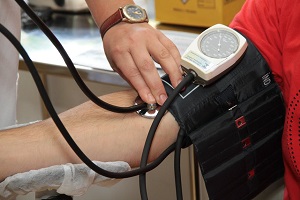I am going to answer the sample USMLE Step 2 CK Questions with Explanation. These questions are available at USMLE.org
A 35-year-old man is brought to the emergency department by a friend 30 minutes after the sudden onset of right-sided weakness and difficulty speaking. The symptoms began while he was lifting weights at the gym. He has not had headache or changes in vision. He has no history of serious illness and takes no medications. He does not smoke cigarettes or drink alcohol. He exercises regularly. His speech is incoherent, but he can understand what others are saying. Vital signs are within normal limits. No bruits are heard over the carotid arteries. Cardiopulmonary examination shows no abnormalities. There is swelling and mild tenderness of the right lower extremity. No cords are palpated. Neurologic examination shows a right facial droop and right upper extremity weakness. An MRI of the brain shows an acute stroke in the left middle cerebral artery territory. Carotid ultrasonography shows no abnormalities.
Which of the following is the most appropriate next step in diagnosis?
(A) Adenosine stress test
(B) Cardiac catheterization
(C) Cardiac MRI with gadolinium
(D) CT angiography
(E) Echocardiography with bubble study
Copyright © 1996-2021 Federation of State Medical Boards (FSMB) and National Board of Medical Examiners (NBME). All rights reserved. The United States Medical Licensing Examination® (USMLE®) is a joint program of the FSMB and NBME.
Answer
Given the absence of significant risk factors for stroke such as smoking, alcohol consumption, or medication use, and the presence of right-sided weakness and difficulty speaking, further investigation is warranted to identify potential sources of emboli that could lead to stroke. A bubble study, performed during echocardiography, is used to detect right-to-left shunting, which can occur in conditions such as patent foramen ovale (PFO). A PFO is a potential source of emboli that could lead to stroke, especially in cases of cryptogenic stroke where no other cause is identified.
Performing an echocardiography with a bubble study will help determine if there is a right-to-left shunt present, which could explain the patient’s stroke. This investigation is particularly important since the carotid ultrasonography showed no abnormalities, indicating that the stroke may be due to an embolic source rather than large artery disease.
The other options (adenosine stress test, cardiac catheterization, cardiac MRI with gadolinium, and CT angiography) are not typically the first-line investigations for evaluating potential embolic sources in a young patient with symptoms suggestive of stroke.
The correct answer is E
